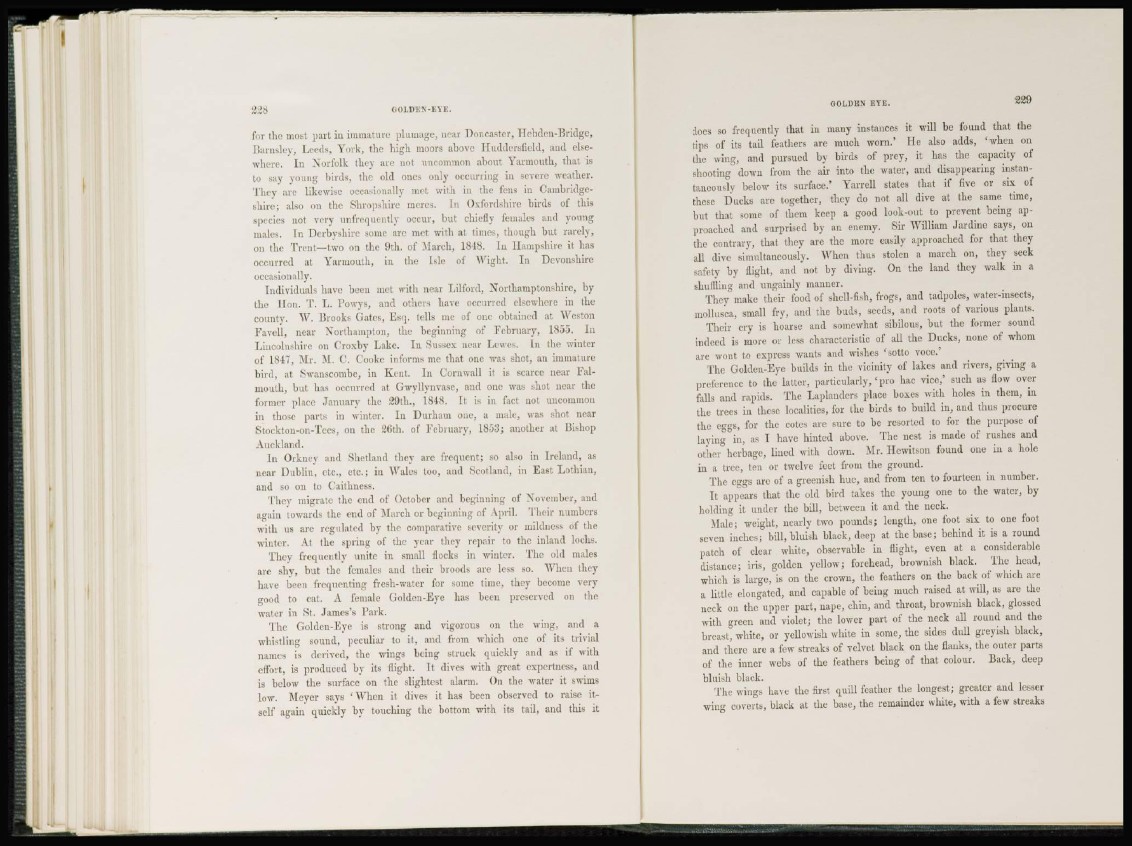
for the most part in immature plumage, near Doncaster, Hcbden-Bridgc,
Barusley, Leeds, York, the high moors above Hudtlersfiehl, and elsewhere.
In Norfolk they are not uncommon about Yarmouth, thai is
to say young birds, the old ones only occurring in severe weather.
They arc likewise occasionally met with in the fens in Cambridgeshire;
also on the Shropshire meres. I • Oxfordshire birds of this
species not very uui'requently occur, but chiefly females and young
males. In Derbyshire some are met with at times, though but rarely,
on the Trent—two on the 9th. of March, 1818. In Hampshire it has
occurred at Yarmouth, in the Isle of Wight. In Devonshire
occasionally.
Individuals have been met with near Lilford, Northamptonshire, by
the lion. T. L. Fowys, and others have occurred elsewhere in the
county. W. Brooks Gates, Esq. tells me of one obtained at Weston
Fa veil, near Northampton, the beginning of February, 1855. In
Lincolnshire on Croxby Lake. In Sussex near Lewes. In the winter
of 1847, Mr. M. C. Cooke informs me that one was shot, an immature
bird, at Swanscombe, in Kent. In Cornwall it is scarce near Falmouth,
but has occurred at Gwyllynvase, and one was shot near the
former place January the 29th., 1848. It is in fact not uncommon
in those parts in winter. In Durham one, a male, was shot near
Stockton-on-Tees, on the 26th. of February, 18-33; another at Bishop
Auckland.
In Orkney and Shetland they are frequent; so also in Ireland, as
near Dublin, etc., etc.; in Wales too, and Scotland, in East Lothian,
and so on to Caithness.
They migrate the end of October and beginning of November, and
again towards the end of March or beginning of April. Their numbers
with us are regulated by the comparative severity or mildness of the
winter. At the spring of the year they repair to the inland lochs.
They frequently unite in small flocks in winter. The old males
are shy, but the females and their broods are less so. When they
have been frequenting fresh-water for some time, they become very
good to cat. A female Golden-Eye has been preserved on the
water in St. James's Bark.
'I he Golden-Eye is strong and vigorous on the wing, and a
whist ling sound, peculiar to it. and from which one of its trivial
names is derived, the wings being struck quickly and as if with
effort, is produced by its night. It dives with great expertness, and
is below the surface on the slightest alarm. On the water it swims
low. Meyer says ' When it dives it has been observed to raise itself
again quickly by touching the bottom with its tail, and this it
does so frequently that in many instances it will be found that the
tips of its tail feathers are much worn.' He also adds, 'when on
the wing, and pursued by birds of prey, it has the capacity of
shooting down from the air into the water, and disappearing instantaneously
below its surface.* Yarrcll states that if five or six of
these Ducks are together, they do not all dive at the same time,
but that some of them keep a good look-out to prevent being approached
and surprised by an enemy. Sir William Jar dine says, on
the contrary, that they are the more easily approached for that they
all dive simultaneously. When thus stolen a march on, they seek
safety by flight, and not by diving. On the land they walk in a
shuffling and ungainly manner.
They make their food of shell-fish, frogs, and tadpoles, water-insects,
mollusca, small fry, and the buds, seeds, and roots of various plants.
Their cry is hoarse and somewhat sibilous, but the former sound
indeed is more or less characteristic of all the Ducks, none of whom
are wont to express wants and wishes 'sotto voce.'
The Golden-Eye builds in the vicinity of lakes and rivers, giving a
preference to the latter, particularly,' pro hac vice,' such as flow over
falls and rapids. The Laplanders place boxes with holes in them, in
the trees in these localities, for the birds to build in, and thus procure
the eggs, for the cotes are sure to be resorted to for the purpose of
laying in, as I have hinted above. The nest is made of rushes and
other herbage, lined with down. Mr. Hcwitson found one in a hole
in a tree, ten or twelve feet from the ground.
The eggs arc of a greenish hue, and from ten to fourteen in number.
I t appears that the old bird takes the young one to the water, by
holding it under the bill, between it and the neck.
Male; weight, nearly two pounds; length, one foot six to one foot
seven inches; bill, bluish black, deep at the base; behind it is a round
patch of clear white, observable in flight, even at a considerable
distance; iris, golden yellow; forehead, brownish black. The head,
which is large, is on the crown, the feathers on the back of which are
a little elongated, and capable of being much raised at will, as are the
neck on the upper part, nape, chin, and throat, brownish black, glossed
with green and violet; the lower part of the neck all round and the
breast, white, or yellowish white in some, the sides dull greyish black,
and there are a few streaks of velvet black on the flanks, the outer parts
of the inner webs of the feathers being of that colour. Back, deep
bluish black.
The wings have the first quill feather the longest; greater and lesser
wing coverts, black at the base, the remainder white, with a few streaks